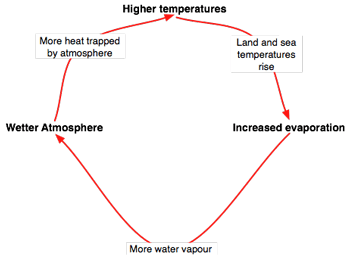1.3. 3: Feedback systems
Systems are continually affected by information they have to react to from both within and outside. Two simplistic examples, if you start to feel cold you can either put on more clothes or turn the heating up. The sense of cold is information putting on clothes is the reaction. Secondly if you feel hungry, you have a choice of reactions that you can take to this “information”
Natural systems act in exactly the same way. The information starts a reaction which in turn may input more information which may start another reaction. This is called a Feedback Loop.
Negative Feedback:this tends to damp down, neutralize or counteract any deviation from an equilibrium, and promotes stability.
Using the example of the Snowshoe Hare / Lynx population cycle presented in the last section
When Hare the population is high, there is surplus food for the Lynx so their numbers go up. This puts a pressure on the Hare population as more are eaten and their numbers fall. Less food for the Lynx so they start to starve and their numbers fall. Fewer Lynx means fewer hares are eaten and their numbers start to go back up. And so it continues as a loop. Explaining it in words is very cumbersome so the diagram is a much better way. Click on the animation to play
 Positive Feedback amplifies or increases change; it leads to exponential deviation away from an equilibrium.
Positive Feedback amplifies or increases change; it leads to exponential deviation away from an equilibrium.
An example of this is the possible effect that rising global temperature could have by adding more water vapor to the atmosphere. Water is a powerful greenhouse molecule trapping heat in the atmosphere. If there is a global temperature rise more water will evaporate trapping more heat making more water evaporate trapping more heat and on and on. Again a diagram helps explain the idea.